
Original Link: https://www.anandtech.com/show/2740
Phenom II X3 720BE & CrossFire X Performance - Does it Compete?
by Gary Key on March 28, 2009 12:00 AM EST- Posted in
- Motherboards
We are back today with a quick update to an article we did a few weeks ago. That article addressed readership questions about how well the Phenom II X4 940 performed against a similar Intel Core 2 Quad (Q9550 in this case) with a multi-GPU setup. It was an interesting request and one that we enjoyed answering. Without repeating the entire article, we discovered the X4 940 was every bit a match for the Q9550 in the majority of our multi-GPU game tests. The one exception was Far Cry 2, but that title just favors Intel’s processors, especially the i7 series.
Our conclusion brought about additional questions. The majority of questions centered on how well the latest Phenom II AM3 processors perform in multi-GPU setups and if DDR3 really makes a difference in performance, application or gaming. We had other comments questioning our sanity and/or heritage after commenting on game play fluidity advantages for the Phenom II in a couple of major titles. We still stand by those comments and might even discuss them again today.
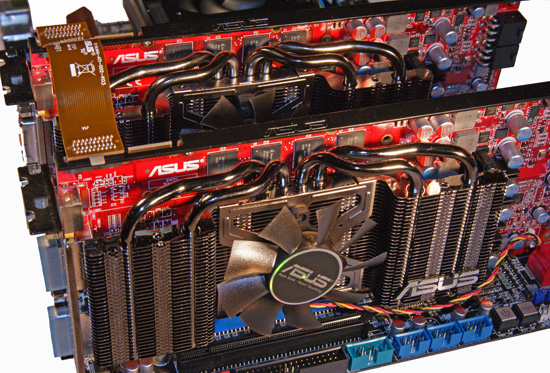
In the meantime, our article today seeks to answer if the Phenom II X3 720BE is a viable alternative to the more expensive Phenom II X4 940 and indirectly the Q9550 in gaming with a CrossFire X setup. We had numerous readers wanting to know how well a “budget” oriented processor would perform in a multi-GPU setup if they decided to divert possible cost savings to procuring an additional mid-range GPU like the HD 4870 1GB. A fair enough question for gaming centric users although we still believe in procuring the single fastest card possible (based on price/performance) for gaming. However, considering current release schedules, pricing, and performance ratios for the higher end GPUs, a more modest dual GPU setup might be a better value proposition over the long term if driver support is consistent.
We will be back shortly to answer the DDR2/DDR3 performance questions and more as we extend our coverage on budget and mid-range platforms. Until then, let’s discuss the system setup and get to the numbers.
Test Setup
Fortunately for us, during motherboard testing we test SLI or CrossFireX solutions extensively. However, we do not test the graphics cards in the same manner as we do in a GPU review. During motherboard testing, we focus on ensuring compatibility, identifying any layout problems, and checking performance deltas between motherboard chipsets. Instead of running absolute GPU intensive settings, we seek a balance of playable settings that ensures decent platform performance. This means reasonable resolutions and 2xAA/8xAF settings to keep the GPU from being a limiting factor where possible. We think these quality settings are fine for most users, especially in FPS games where the differences between 2xAA, 4xAA, or 8xAA are usually minimized due to the speed of the game.
We run our benchmarks at two of the most popular resolutions for new systems, which happen to be 1680x1050 and 1920x1200, although 1920x1080 is gaining traction quickly. We mention this now as our overview of CrossFireX performance will not have 2560x1600 at 4xAA/16xAF results or tri-card setups. The population of 30” monitors is rather small and except for Crysis, tri-card performance is usually worse or at best a break even experience compared to dual card performance with our mid-range setups. Consider this review a snapshot of CrossFireX performance with one particular GPU selection as we will not be looking at other ATI cards except the HD4870 1GB.
Our test systems today are based on similar components where possible. The Intel Core 2 Quad and AMD Phenom II platforms will satisfy the requirements of most enthusiasts looking for great performance from mid-range setups. We selected a “mid-range” Core i7 setup that is capable of both SLI and CrossFire to ensure platform consistency in future articles.
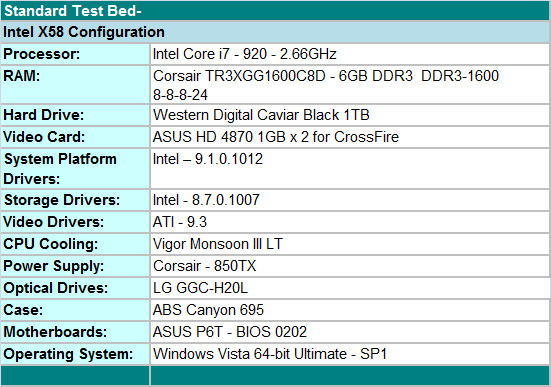
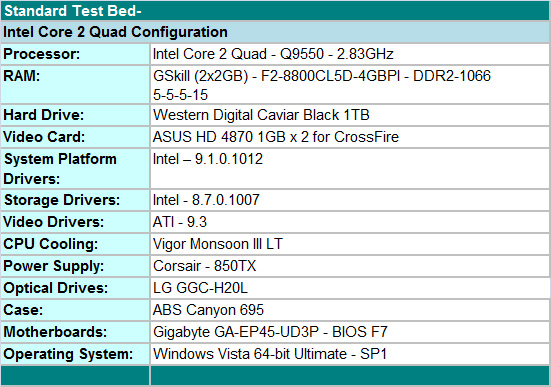
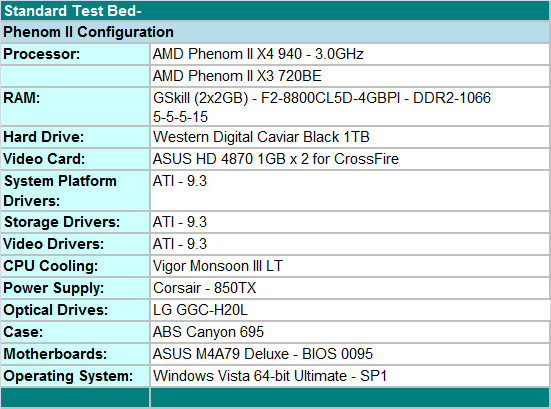
Our decision to go with a 790FX/SB750 combination on the AMD side is strictly based upon performance. The 790FX is about 3%~5% faster on average than comparable 790GX products in multi-GPU configurations. AMD continues to recommend the 790GX/SB750 as the platform of choice for the AM2+ and upcoming AM3 products. We disagree from a performance viewpoint; the 790FX/SB750 combination is simply the best choice in our opinion. Of course you will typically pay about $35~$40 or greater for the 790FX boards, but if you intend on running CrossFireX or benchmarking, we think it is worth the additional cost. We changed motherboards from our original DFI selection to the ASUS M4A79 Deluxe as we will be utilizing the M4A79T Deluxe in an upcoming DDR2/DDR3 memory comparison article.
On the Intel side, we decided to go with the P45 chipset as it offers a very balanced blend of performance and value. The Gigabyte GA-EP45-UD3P is a superb CrossFire capable motherboard that also happens to be one of the best overclocking S775 products around. The P45 offers dual PCI Express x8 operation in CrossFire mode compared to dual x16 on the 790FX, X48, and X58 boards. However, we did not notice any performance differences between dual x8 and dual x16 operation when comparing the P45 to the X48 in offline testing utilizing our resolutions and quality settings.
The i7 setup can be cost reduced easily without sacrificing any "real and perceivable" performance due to a motherboard and memory alternatives currently available in this market sector. If you are only interested in CrossFire capability on the X58, motherboard costs are now in the sub $200 range. The price of DDR3 has dropped dramatically this last month with very good DDR3-1333 6GB memory kits going for $90 or so now.
We selected the ASUS EAH4870 DK/HTDI/1GD5 video card. It is a non-reference design that offers improved thermals and acoustics over the standard HD4870 1GB cards on our board choices. We think if a user is going to run CrossFireX on one of these platforms, then the best possible performance choice is the HD4870 1GB, at least until the HD 4890 ships next week. Depending upon pricing on the HD 4870 1GB cards or upcoming HD 4890 cards, a 4870X2 might be a better choice for users wanting CrossFireX.
The WD Caviar Black 1TB is our hard drive of choice for storage purposes. LG’s Blu-ray playback capable drive fills in for optical duties. We purchased two of G.Skill's impressive DDR2-1100 4GB kits that operate at speeds up to DDR2-1240 on our boards with about 2.1V of VDimm. We used 4GB in our Phenom II and Core 2 Quad systems with memory set at DDR2-1066 with 5-5-5-15 timings at 1.8V. Our DDR3-1600 6GB kit is from Corsair and was dialed in at DDR3-1600 with 8-8-8-24 1T timings at 1.60V. Vigor provided their Monsoon III LT CPU cooler that offers mounting kits for the 1366, 775, and AM2+/AM3 processors. ABS provided their Canyon 695 case and it has proved to be exemplary during testing.
Our game selections are a few of the recent top selling titles. Certain titles that are capped at 30FPS like Command and Conquer Red Alert 3 or do not benefit from CrossFireX (Flight Simulator X) were not included. We tested Grand Theft Auto IV with the latest 1.03 patch but those results are not available today.
We are also including results with our processors overclocked for CrossFire only. Overclock results with a single card configuration provided little benefit in most cases. Simply overclocking the video cards resulted in better performance numbers than overclocking the processors with this configuration. We switched from the 8.12 driver set to the 9.3 for this article. The overall numbers are extremely close between the two driver sets. The only measurable differences we noticed occurred in Crysis Warhead where the Intel platforms performed better at 1920x1200 and in CrossFire performance.
The Phenom II 940 in our previous article was overclocked to 3.95GHz (17.5x226, DDR2-1205, 5-5-5-18, NB Speed 2486Mhz), however, we discovered in later testing that performance just was not where it should have been at that CPU speed. Part of the problem was thermal related as we were bumping right up against the limits of the CPU and board on air cooling. Also our BIOS was not fully optimized for the Phenom II 940 and we continue to experience instability and performance degradation near 4GHz with Vista 64. A problem that we are still working on with AMD.
As such, we set our Phenom II X4 940 overclock to 3.8GHz (19x200, DDR2-1066 5-5-5-15, optimal sub-timings) and realized that the performance delta was minimal compared to previous results. In fact, it was so minimal that our original conclusions have not changed at all. We also clocked our Phenom II X3 720BE to the same 3.8GHz core speed with like memory settings. The only difference between the settings (includes optimal memory sub-timings) is that the Northbridge speed on the 940 defaults to 1.8GHz compared to 2GHz on the 720BE. We will look at the effects of Northbridge speeds in a separate article shortly, but our recommendation is to run it at 2.6GHz+ ASAP.
The Core 2 Quad Q9550 is set at 4.25GHz (8.5x500, DDR2-1000, 5-4-4-12), and the Core i7 920 at 4GHz (20x200, DDR3-1600, 8-8-8-24). These were the maximum stable overclocks on air-cooling that we could sustain in a 24/7 setup with Vista Ultimate 64 SP1. Our particular 940 processor will hit 4.2GHz under Vista 32 and the 720BE tops out around 4.15GHz before requiring additional cooling. We just want to reiterate one more time that we are not crippling the AMD systems on purpose. There is a definite clocking problem with the Phenom II series under Vista 64 without resorting to exotic cooling methods. Our standard test beds have all moved to Vista 64 Ultimate SP1 and will soon move to Windows 7 64 along with a very 64-bit centric application test suite. As such, it is what it is until AMD can provide a solution to this problem.
Call of Duty: World at War

While not our favorite Call of Duty game, World at War certainly improves upon the graphics quality of previous versions. We play through the first few minutes of the Semper FI level by following a repeatable course and capture our performance results with FRAPS. We set the various graphics and texture options to their highest settings with AA at 2x and AF at 8x.
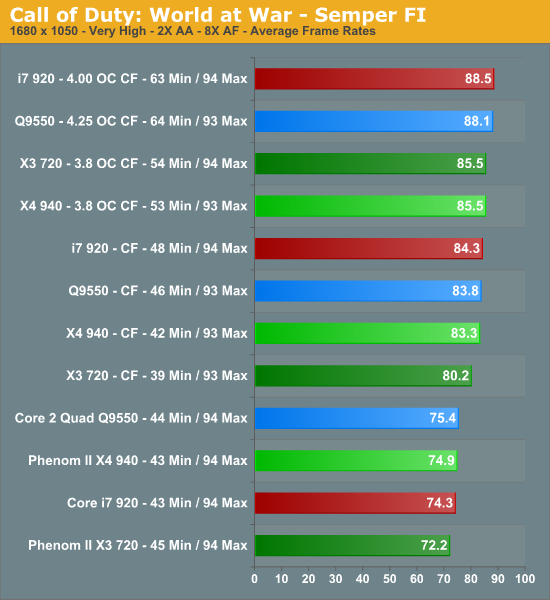
This game is not particularly hard on either the GPU or CPU, but we do hit a hard cap at 94fps. At 1680x1050 the Phenom II X3 720BE (henceforth, 720BE) is around 4% slower in average frame rates than the X4 940 in single card and CrossFire X mode due to a 200MHz clock speed advantage in this game. When overclocked, the 720BE equals the X4 940, although both trail the Intel platforms by 3% in average frame rates and 18% in minimum frame rates.
Adding a second card for CrossFire operation improves average frame rates by 11%, but minimum frame rates decrease 14% for the 720BE. Overclocking the 720BE resulted in a 6% improvement in average frame rates and 35% in minimum frame rates in CrossFire performance.

We have roughly the same performance results at 1920x1200 when comparing the platforms. The Phenom II X3 720BE is competitive with the Intel platforms and X4 940 in single card and CrossFire operation, though minimum frame rates in CrossFire mode trail the other solutions up to 17%. Once we overclock the CPUs, the minimum frame rate is about 15% lower on the Phenom II processors compared to the Intel products.
Installing a second card for CrossFire operation improves average frame rates by 25% and minimum frame rates increase 5% for the 720BE. Overclocking the 720BE resulted in a 7% improvement in average frame rates and 37% in minimum frame rates.
We did not notice any difference in game play quality at either resolution between the platforms after playing through several of the levels. Each platform offered a very smooth and fluid gaming experience. We thought the higher minimum frame rates on the Intel systems would be noticeable during the heavy action scenes in the jungle, but honestly, we could not tell the systems apart during testing. The 720BE provided an equal gaming experience to the other processors with our settings.
Crysis Warhead
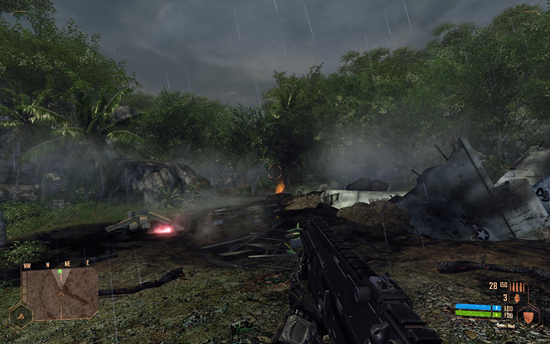
Crysis Warhead is an update to the original game with a storyline that takes place on the other side of the Island during the same time-period as the first. The game features an enhanced and optimized version of the CryEngine 2 but is still a resource monster. We set the graphics options to Gamer, DX10, and 2xAA. Our timedemo covers the Ambush level and we take an average score of three test runs. We have to admit at these settings that the game looks fantastic during action scenes and game play is very acceptable even though the frame rates are lower than our other games.

At 1680x1050, the 720BE slightly trails the other platforms in single card and CrossFire configurations. We also see why a single GPU card can be a better value than a dual GPU solution at this resolution. It is not until we overclock that we notice some separation between the platforms with the i7 taking a decent lead, but its minimum frame rates do not improve compared to a single card setup. However, our X4 940 setup offers the best minimum frame rates when overclocked and the 720BE ties the i7.
Adding a second card for CrossFire operation improves average frame rates by 3% and minimum frame rates by 12% for the 720BE. Overclocking the 720BE in CrossFire mode resulted in a 22% improvement in average frame rates with the CPU being overclocked by 35%.
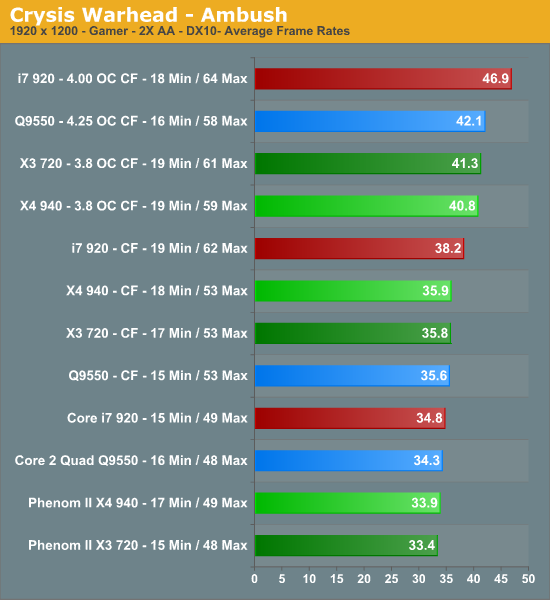
Our 1920x1200 test follows a similar performance pattern in single card and CrossFire testing. Only this time the 720BE performs better as an additional load in placed on the GPU subsystem. The 720BE trails the Q9550 by 3% in our overclock results although it is at a 12% clock speed disadvantage. We have
noticed CryEngine 2 will respond to improved memory bandwidth and
latencies as we clock up the processors, hence the performance of the i7 and to some degree the Phenom II. When overclocked, the two Phenom II CPUs hold the advantage in minimum frame rates, an important distinction in ensuring smooth game play in this title.
Adding a second card for CrossFire operation improves average frame rates by 7% and minimum frame rates by 13% for the 720BE. Overclocking the 720BE in CrossFire resulted in a 15% improvement in average frame rates and 12% in minimum frame rates.
After playing through several levels on each platform, even with the improved performance of the Q9550 after switching to the 9.3 driver set, we thought the Phenom II 940/720BE offered a better overall gaming experience in this title. Are we going to say those three words again? Our therapist advised us not to hold our feelings in as they would eventually manifest and be channeled into a bad review for someone. So without further adieu, Smoother Game Play, Smoother Game Play.
That feels better, but all joking aside, we simply experienced better player movement and weapon control during heavy action sequences with our Phenom II processors compared to the Q9550 platform. This was especially true if we were running background applications (IM, File Transfers, AntiVirus, etc.) and especially if CPU usage was over 90%, the Phenom II system never stuttered or gave us a slight pause between level transitions like the Q9550 (editor - Sounds like an SSD review).
It might not be noticeable to everyone and at first we thought it was a placebo effect, but doing a blind test with an A/B box always lead us to the Phenom II. The $64 question is if we had the same user experience with the i7 platform. The answer is yes. The i7 offered an improved game play experience over the Q9550 platform based on the same reasons we listed for the Phenom II. Simply put, integrated memory controller and CSI/HTT platform designs perform better than the previous front side bus platforms with these type of system loads.
FarCry 2
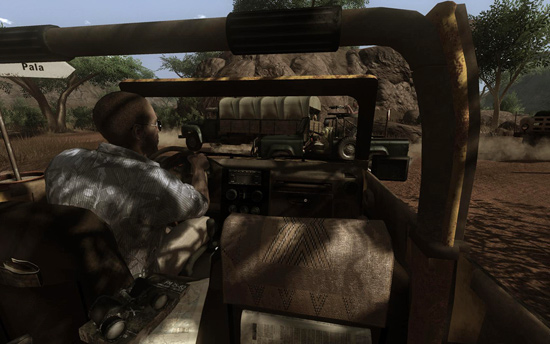
This title has beautiful graphics, an open ended environment, and is fun to play... but traveling between missions tends to get repetitive. If you dial up the graphics options, the game rewards with you some fantastic visuals courtesy of the Dunia Engine. The game also features the most impressive benchmark tool we have seen in a PC game. We set the performance feature set to Very High, graphics to High, and enable DX10 with AA set to 2x. The in-game benchmark tool is utilized with the Ranch Small level and we report an average of three test runs.
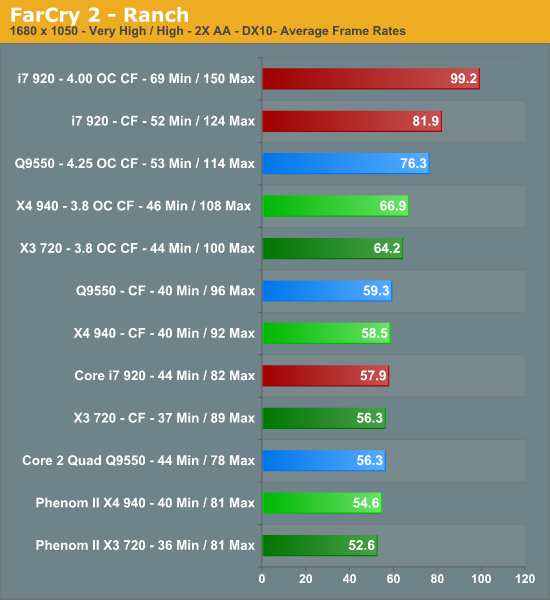
Two things still hold true about this game. It favors the Intel processors, and once you provide enough GPU horsepower, the performance of the i7 platform is untouchable. If you wanted to pick a single benchmark and show a large disparity in gaming performance between the Intel and AMD platforms, this is the one to use. Does that mean the game play experience on the Phenom II platform is bad, certainly not, in fact it is very good. However, you can run higher resolutions and/or quality settings on the i7 platform and improve your game play experience without affecting performance.
In the 1680x1050 single card and CrossFire test, the 720BE trails the X940 by 4% on average even with a clock speed disadvantage of 7%. The 720BE does hold an L3 cache per core and Northbridge speed advantage but clock speed is still important in the game. Adding a second card for CrossFire operation improves average frame rates by 7% and minimum frame rates less than 1% for the 720BE. Once we overclock our 720BE, average frame rates increase 14% and minimum frame rates 19% over stock CF numbers.
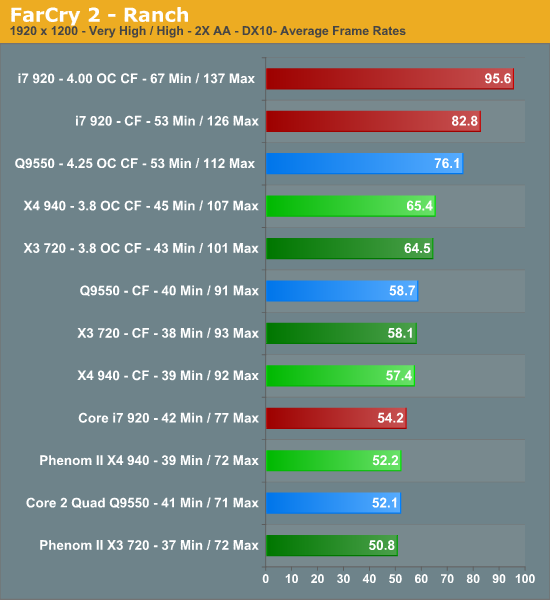
At 1920x1200, the benchmarks reveal nothing new between the platforms. The Phenom II processors are competitive with a single card configuration with the 720BE only trailing the X4 940 by 3%. As we start to become CPU/GPU limited the 720BE trails the X4 940 by less than a 1% in the CrossFire tests. Adding a second card to the 720BE system for CrossFire operation improves average frame rates by 14% and minimum frame rates by less than 1%. Neither Phenom II competes with the Q9550 in either average or minimum frame rates. The i7 is just stupid fast in these benchmarks compared to the other systems.
When it comes to game play experience and not benchmark tests, all three platforms behaved in a similar manner at our specified settings. We did not notice any advantages with the improved frame rates that the i7 offers over the other two platforms. However, with the i7 we could change the graphic settings to Very High and increase AA to 4x and still experience very good game play. It was as if nothing changed except now we were looking at the savannahs of Africa in a much better way. These same settings were not always a pleasant experience on the other two platforms during heavy action scenes, but the game remained playable for the most part.
Increasing Northbridge Speed for Performance Improvements
One of the quickest ways to extract additional performance on the Phenom II (also Phenom) platform is to increase Northbridge speeds. We are working on a separate article covering the advantages and disadvantages of this setting. Our initial results are positive for applications that heavily depend on memory throughput and low latencies. We thought it would be interesting to see what would occur if the Northbridge speed was raised from a stock 2GHz level to 2.8GHz on our 720BE processor in Far Cry 2. This is worst comparative game title for our AMD Phenom II processors today, so let's see if we have any performance improvements at 1680x1050.
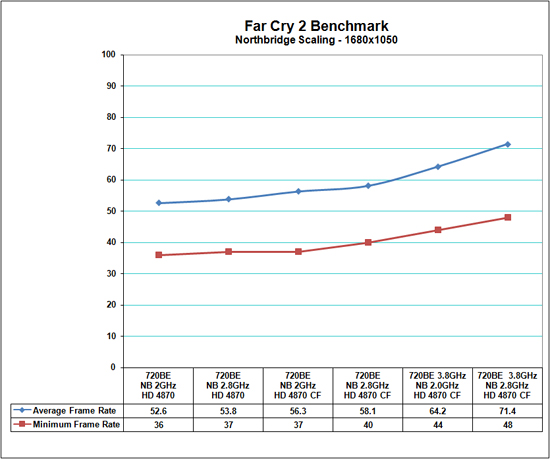
At stock processor speeds with a single video card there is a 2% increase in average and minimum frame rates. We did not expect much as the data pipeline is not under a lot of stress at this point. As we move to our CrossFire X configuration at stock CPU speeds there is a 3% increase in average frame rates and 8% in minimum frame rates. Now it gets interesting as we overclock our CPU to 3.8GHz and are able to feed the data pipelines in a proper manner, at least we thought so. By increasing our NB speed to 2.8GHz, the average frame rates increase 11% and minimum frame rates increase 9%. We have noticed similar results at 1920x1200 in this game and in other applications.
All that required was a simple increase in CPU/NB VID from 1.200V to 1.375V with this particular CPU. Some CPUs will require additional voltage and/or improved cooling to clock up the Northbridge speed to this level. In our experiences to date with the Phenom II processors, all of our samples have hit 2.8GHz with 1.375V to 1.425V on good air-cooling.
Left 4 Dead
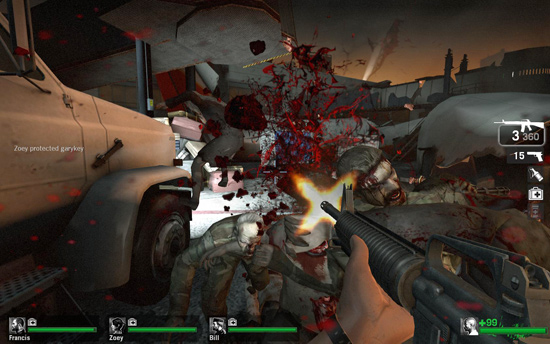
This game is a blast and addictive to boot - provided you like killing hundreds of zombies while trying to take care of your teammates and sustaining high blood pressure rates. What we really like about Source engine games is their ability to run well on variety of systems. We enable all options, set AA to 2x and AF to 8x, and play back a custom timedemo of a complete game session from the Runway chapter within the Dead Air campaign.
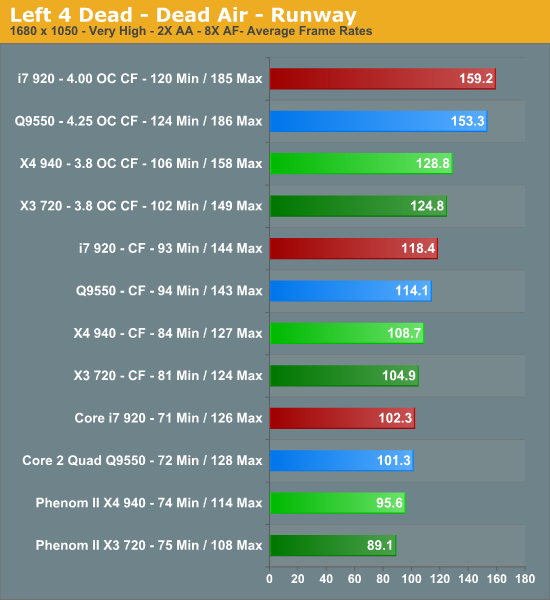
This title also favors the Intel processors. When comparing the 720BE to the X4 940 at 1680x1050, the 940 holds a 7% average frame rate advantage in single card mode, 4% in Crossfire, and a surprising 3% in the overclocked settings. We matched our stock 720BE clock and NB speeds with the X4 940 to see if the extra core really makes a difference in this game with the multi-core rendering option enabled. It actually did with the performance improvement averaging about 2% on this particular level.
Adding a second card for CrossFire operation improves average frame rates by 17% and minimum frame rates by 8% for the 720BE. Overclocking our 720BE by 35% resulted in a 19% improvement in average frame rates and 26% in minimum frame rates.
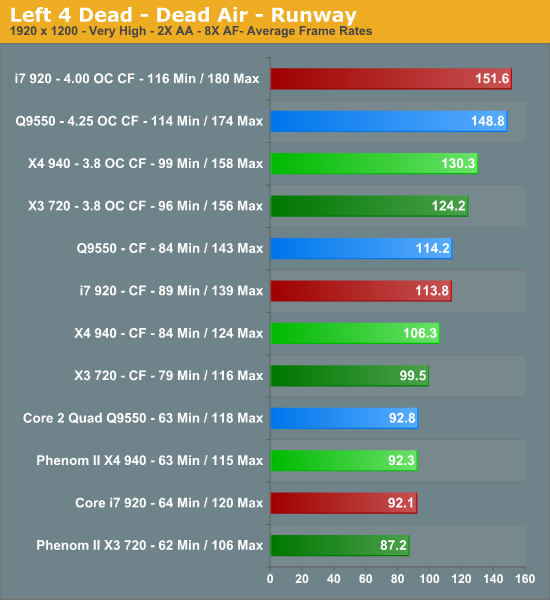
No real surprises here; the 1920x1200 results follow the pattern set at 1680x1050 for each platform. The X4 940 holds a 6% average frame rate advantage in single card mode, 7% in Crossfire, and 5% in the overclocked settings. Adding a second card for CrossFire operation improves average frame rates by 14% and minimum frame rates by 27% for the 720BE. Overclocking the 720BE resulted in a 25% improvement in average frame rates and 21% in minimum frame rates.
Our game play experiences revealed no differences between the three platforms. Although the frame rates were lower with the Phenom II platforms, it just did not matter in this game as minimum frame rates were at 60fps or higher in our tests. The 720BE certainly offers more than enough processing power for this title.
Race Driver: GRID
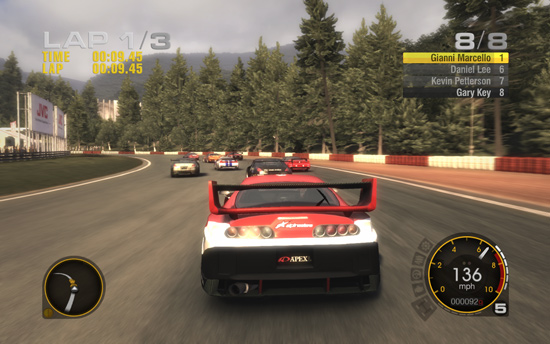
The more serious racing fans on the staff tend to end up at iRacing.com or playing a modified version of Grand Prix Legends for our racing simulation fix. However, there comes a time to throw out physics and just have some fun. In that case, GRID is the game we play. We turn up all the options, set AA to 2x, and let the rubber burn in a Race Day event. Our results are captured via FRAPS and we average three test runs for our final score.

At 1680x1050 in single card mode, we have a surprise winner here with the 720BE placing first. Of course, all four platforms have very close scores, but the Phenom II X3 720BE get the trophy. The 720BE leads the X4 940 by less than a percent in our tests. We raised the Northbridge speed on the X4 940 from 1.8GHz to 2.0GHz and noticed almost identical results with the X3 720BE scores listed. Adding a second card for CrossFire operation improves average frame rates by 6% and minimum frame rates by 9% for the 720BE. Overclocking this little gem resulted in an 23% average improvement in average frame rates and 22% in minimum frame rates. Of course, the i7 platform offers excellent performance in CrossFire operation as indicated by the numbers. The Q9550 needs a 12% overclock advantage to surpass the Phenom II systems.
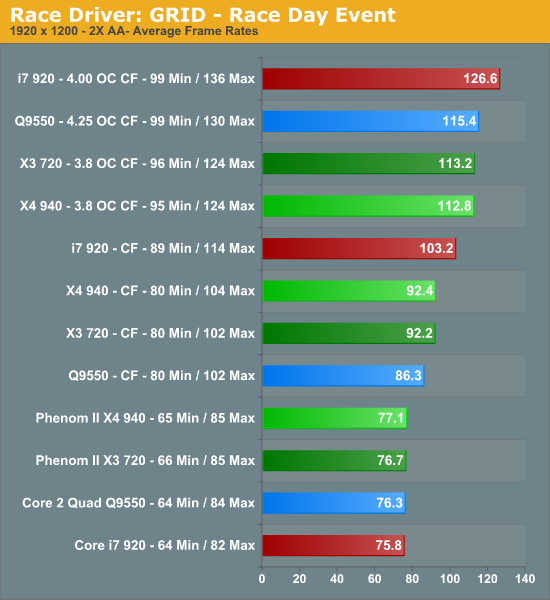
Turning the resolution up to 1920x1200 results in a similar pattern across platforms at 1680x1050. Our Phenom II systems trade places at this resolution in the single card and CrossFire results, although the scores are within our .05% margin of error. Spending an additional $199 for that second card will improve average frame rates by 20% and minimum frame rates by 14% for the 720BE. Spending $50 for a good air cooler and overclocking the 720BE resulted in a 23% improvement in average frame rates and 20% in minimum frame rates.
Once again, our game play experience indicates there is no difference between the four platforms at our particular settings. Although frame rates were higher with the i7 in CrossFire mode, there was no appreciable difference in game play quality. The X3 720BE is every bit the match of the its more expensive cousin, the X4 940, in this game.
Company of Heroes: Opposing Fronts
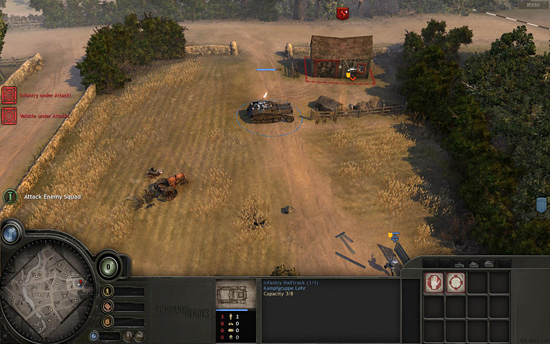
The oldest title in our test suite is still the most played. CoH has aged like fine wine and we still find it to be one of the best RTS games on the market. We look forward to the Tales of Valor standalone expansion in a couple of weeks. In the meantime, we crank all the options up to their highest settings, enable AA at 2x, and run the game under DX9. The DX10 patch offers some improved visuals but with a premium penalty in frame rates. We track a custom replay of Able Company’s assault at Omaha Beach with FRAPS and average three test runs for our results.
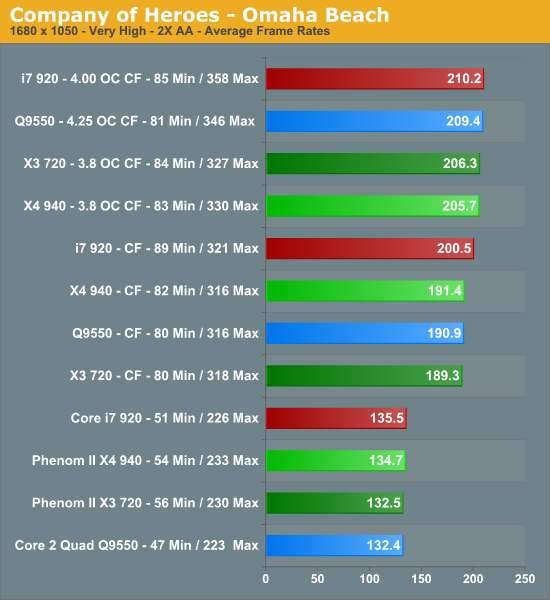
Single card scores at 1680x1050 are fairly close between each platform. In this particular game, the Phenom II X4 940 offers slight better performance than the X3 720BE in the single card and CrossFire results with a 1% advantage thanks to a higher clock speed. When overclocked the 720BE finishes ahead ever so slightly but within our margin of error on the benchmark. Installing a second card for CrossFire operation improves average frame rates by 42% and minimum frame rates by 43% for the X3 720BE. Overclocking the 720BE resulted in a 9% improvement in average frame rates and 5% in minimum frame rates, indicating we are largely GPU limited at this point.
In our previous testing with the 8.12 drivers, the Intel systems would generate minimum frame rates in the 23~24fps range on a couple of runs and then jump to their current results or higher on the others. Guess what, we still noticed that problem with the 9.3 drivers. However, the hitch and pausing we encountered previously was mitigated somewhat in our new tests. It was only in intensive ground scenes with numerous units that we really noticed the problem and it was primarily with the Q9550 platform. Both Phenom II systems had extremely stable frame rates along with very fluid game play during the heavy action sequences.
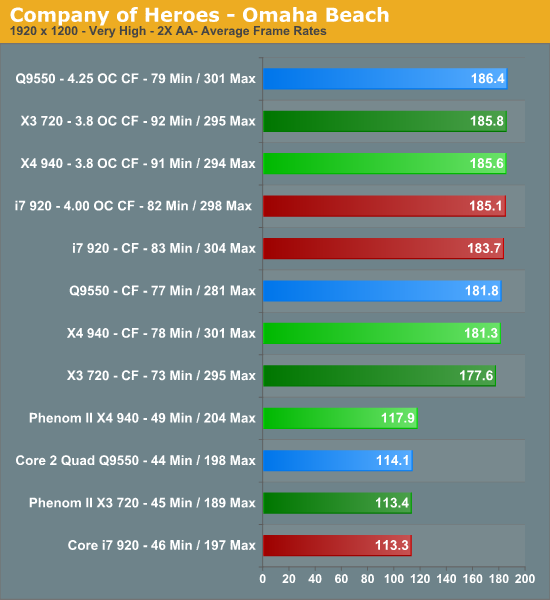
The Phenom II X4 940 leads the group at 1920x1200 with a single card. The X4 940 is 4% faster in average frame rates in single card mode and 2% faster than the 720BE in CrossFire. The X4 940 has a 8% advantage in minimum frame rates in single card results and 7% in CrossFire. When overclocked, both Phenoms are equal for all intent purposes. Adding a second card for CrossFire operation improves average frame rates by 57% and minimum frame rates by 62% for the 720BE. Overclocking the 720BE only improved frame rates 5% as we continue to be GPU bound at this resolution.
What about the game play experience? As we mentioned earlier, the Intel Q9550 platform had some problems with minimum frame rates throughout testing - not just in the benchmarks, but also during game play in various levels and online. The i7 platform would behave in the same manner at times, but the game play experience with it has certainly improved with the 9.3 driver set and BIOS upgrades. The problem is very likely driver related in some manner (as the man who helped to start DirectX once put it, "the drivers are always broken"), but nevertheless this continues to be a problem on the two Intel platforms.
We could not discern any differences between the X3 720BE and the X4 940 during game play. Actually, how could we, the frame rates were basically even in all situations. Even the slight gap in minimum frame rate differences between the two processors did not create any problems during our gaming sessions.
Final Words
The question we wanted to answer in this article, “Is the Phenom II X3 720BE an alternative to the Phenom II X4 940 for a mid-range gaming system featuring CrossFireX?” We have to enthusiastically answer with “Yes!” to that question based on our experiences with the games we tested today and several others offline.
In fact, we think it even compared well to the Q9550 in our gaming tests. The Phenom II X3 720BE does not match the performance of the X4 940 or Q9550 in application testing, but it is no slouch either, especially considering the $136 price tag and overclocking capabilities. Compared directly to the $215 X4 940, we think the X3 720BE is a better value if gaming is your priority. Sure, any performance differences might be greater with a GTX 295 or 4870X2 at 2560x1600 resolutions, but we are discussing the performance capabilities of mainstream processors and video cards at two of the most popular gaming resolutions today.
When it came to actual game play experiences, our opinions still have not changed when it comes to a choice between the Phenom II or Core 2 Quad. The Phenom II processors are a better choice in Company of Heroes: Opposing Fronts and Crysis Warhead due to fluidity of game play, especially with background tasks running or CPU utilization near 100%. In the four other titles, we could not tell any real differences in the quality of game play between the Phenom II X4 940, Phenom II X3 720BE, or Core 2 Quad Q9550.
We included the i7 platform performance results as a measuring gauge to how well our test platforms compare to the latest and greatest from Intel when utilizing mid-range components at popular game resolutions. Strictly going by the numbers and game play experiences, we would be remiss in not recommending this platform for users who can afford it, especially gamers looking for a multi-GPU setup to run at higher resolutions or those who are serious about video/audio digital content creation.
We have praised the Phenom II X3 720BE since its launch and continue to believe it is an excellent value for the money. Some of us on staff are very enthusiastic about it for a variety of reasons. The primary one being this processor’s performance and cost advantage allows you additional flexibility in upgrading other components in your system. If you are on a limited budget as most of us are at this time, the money saved purchasing this processor over the X4 940 or Q9550 can be utilized to procure a higher end video card as an example. For a gamer, this means the ability to step up to an AMD HD 4870 1GB or NVIDIA GTX 260 video card instead of settling for a HD 4850 or GTS 250 without really affecting platform performance compared to the higher end processors.
In the end, it is always a compromise when putting a system together without unlimited funds, especially when the average user will perform a multitude of different tasks on the same system. For the typical gamer, this processor brings a lot to the table from a cost/performance viewpoint. It is every the bit the equal of the Phenom II X4 940 and in most cases the Core 2 Quad Q9550 when paired up with mid-range video cards and monitors. If you fall into the limited funds category, then we highly suggest you give the Phenom II X3 720BE serious consideration when upgrading your next system.







